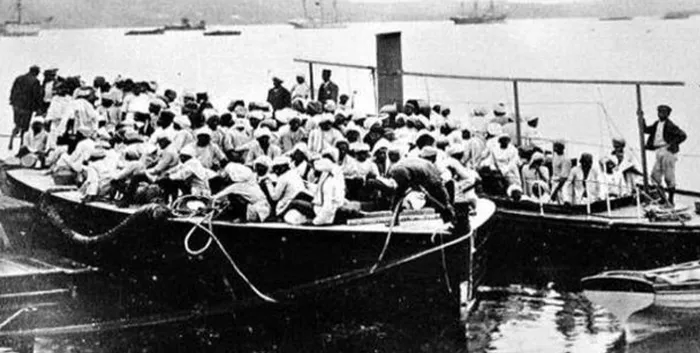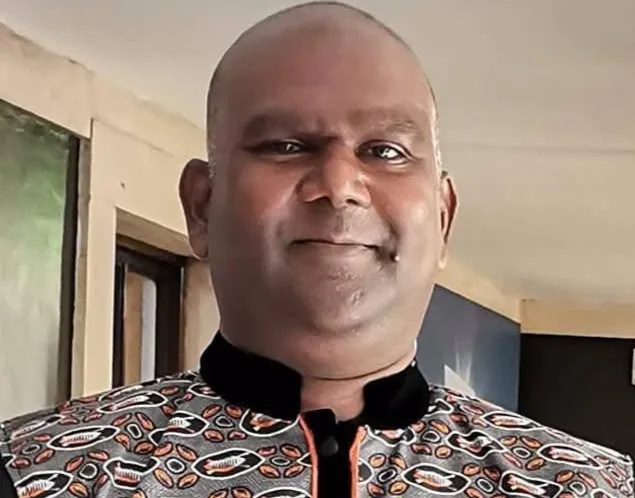Carriers of the Light for the common good
Resilience

The first Indian indentured labourers arrive in Durban harbour aboard the Truro in 1860.
Image: File
IT IS A celebration that sets the subcontinent ablaze with a million points of light. This is Diwali, the great festival of lights, a sublime testament to the triumph of radiance over obscurity, of good over the profoundest evil. Imagine, if you will, the scene in its quintessential, unadulterated glory: the smoky, fragrant dusk alive with the flutter of flames from countless diyas, each tiny earthen lamp a defiant sun against the encroaching night. They line the edges of homes, spill from windowsills, and float like constellations upon sacred rivers, their warm, honeyed glow painting the world in hues of gold and saffron.
And yet, in the autumn of 1860, as this pageantry of light and life reached its crescendo across the dusty plains of Bihar and other states, a starkly different reality was unfolding for 342 souls. For them, the lamps had dimmed. The fireworks were a memory. The laughter had died in their throats, replaced by the monotonous, groaning heartbeat of a steam engine. They were aboard the SS Truro, a vessel of iron and ambition, carving a solitary path across the implacable darkness of the Indian Ocean.
The first shock was not of the landscape, though its unfamiliar greens and sharp light were an assault on senses accustomed to the soft, golden haze of the Gangetic plain. The primary shock was commodification. They were herded from the heaving deck into a world of forms and numbers, their identities, once woven from caste, lineage, and village stripped away and replaced with a cold, sequential digit in a ledger. This was the ritual of registration, a profane ceremony where the complex symbolism of their names was mangled by indifferent clerks.
Then came the health checks, a humiliating inventory conducted under the gaze of men who saw not souls, but specimens. They were poked and prodded, their bodies assessed for strength and stamina like cattle at a market. From the holding sheds, the final, disorienting blow fell, allocation. Families and village groups, the last fragile vestiges of their old world, were callously splintered. A man who had shared the horrors of the kala pani with his neighbour might now be sent to a sugar estate a hundred miles distant, their bond severed by the stroke of a pen. They were dispersed like chaff to the winds of Natal, to the vast, monotonous cane fields that stretched like a green sea.
This, then, was the promised "better life": a life registered, examined, allocated, and housed within a system designed to extract every ounce of their strength while granting the bare minimum of their humanity. They had crossed the ocean, not as pilgrims, but as pawns. The voyage had ended. The real struggle had just begun.
For the system of indenture, in its ruthless calculus, had accounted for the muscle in their arms and the sweat on their brows, but it had fatally overlooked the immutable spark in their souls. They arrived with nothing but the tattered clothes on their backs and the invisible, indestructible cargo of their civiliSation. From the meagre pittances scraped from their gruelling labour, a few shillings saved from wages designed to perpetuate bondage, they performed a modern-day miracle. They transmuted despair into dignity, and pennies into permanence.
The sacred impulse, so violently suppressed on the plantations, could not be extinguished. The same hands that bled from cutting cane, now, in their scant hours of rest, began to mould clay for deities and stack bricks for sanctuaries. Temples rose, humble at first, then increasingly ornate, their familiar silhouettes against the African sky a defiant declaration of identity. Mosques found their Qibla, their minarets, a new axis of faith. Churches, too, were built, testament to a community that found solace in diverse paths to the divine. These were not mere buildings; it was the re-kindling of the lamps that had been so nearly snuffed out on the dark ocean.
But their vision of the common good extended far beyond the spiritual. They understood, with a wisdom born of collective suffering, that their only possible victory lay in unity and upliftment. They pooled their infinitesimal resources to build not just places of worship, but the very architecture of a thriving society. Community halls became hubs of recreation and resistance, where the strains of the harmonium and the rhythms of the dholak fought the soul-crushing monotony of plantation life. They built schools, recognising that the key to their children’s liberation lay not in the field, but in the mind. With a collective determination that shames our modern equivocations, they funded scholarships, identifying the most promising students and purchasing for them, coin by hard-won coin, the priceless gift of an education.
Yet, their conception of dharma, of righteous duty could not be confined to the boundaries of their own community. The same fervour that built temples and schools soon discerned a larger, more pervasive darkness that required confrontation: the systemic injustice of apartheid. Their own struggle for dignity had schooled them in the anatomy of oppression, and they recognised its familiar face in the plight of their African brothers and sisters. From the meagre earnings that had built their own institutions, they now channelled funds towards a greater, national liberation.
They understood that their own freedom was inextricably linked to the freedom of all. This conviction found its political voice in the formation of the Natal Indian Congress (NIC) in 1894, an organization birthed from the fire of Mahatma Gandhi’s early activism. But this was not a fleeting alliance. It was a deep, abiding, and strategic partnership, a conscious choice to stand shoulder-to-shoulder with the African National Congress in the long, arduous march toward democracy.
They were not merely supporters; they were architects of the struggle. Their halls hosted clandestine meetings; their printers ran off subversive pamphlets; their leaders, like the brilliant Monty Naicker and Yusuf Dadoo, fought legal battles and articulated a vision of a non-racial South Africa. They endured the bans, the detentions, and the brutality of the state, their sacrifices written not only in the ledgers of their own community but in the very annals of the nation's fight for freedom.
This was the ultimate extension of their sacrifice: to risk the very institutions they had so painstakingly built, to stand for a principle that was larger than themselves. In doing so, they transformed their narrative from one of a community seeking its own place, to that of a people helping to midwife a new nation for all. The light they had kindled in their temples now became a torch for the entire country, a steadfast beacon in the long night of apartheid. On this anniversary we remember them with reverence and fondness, for they were epic builders of the public good. An inspiration and ideal worthy of emulation as we see around us Universities, Libraries and public amenities burn and crash.

Yogan Naidoo
Image: Supplied
Yogan Naidoo is a graduate of International Relations (LSE), and activist for peace and harmony through spirituality.
** The views expressed do not necessarily reflect the views of IOL or Independent Media.
Related Topics: